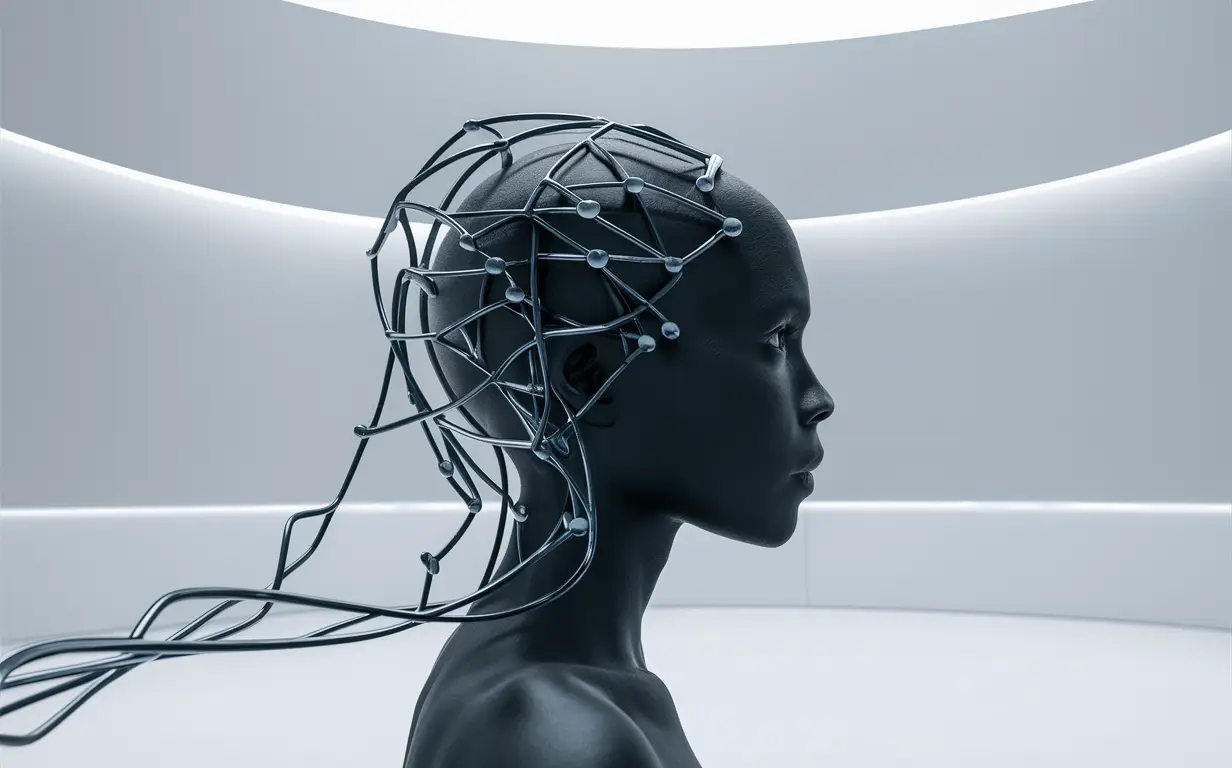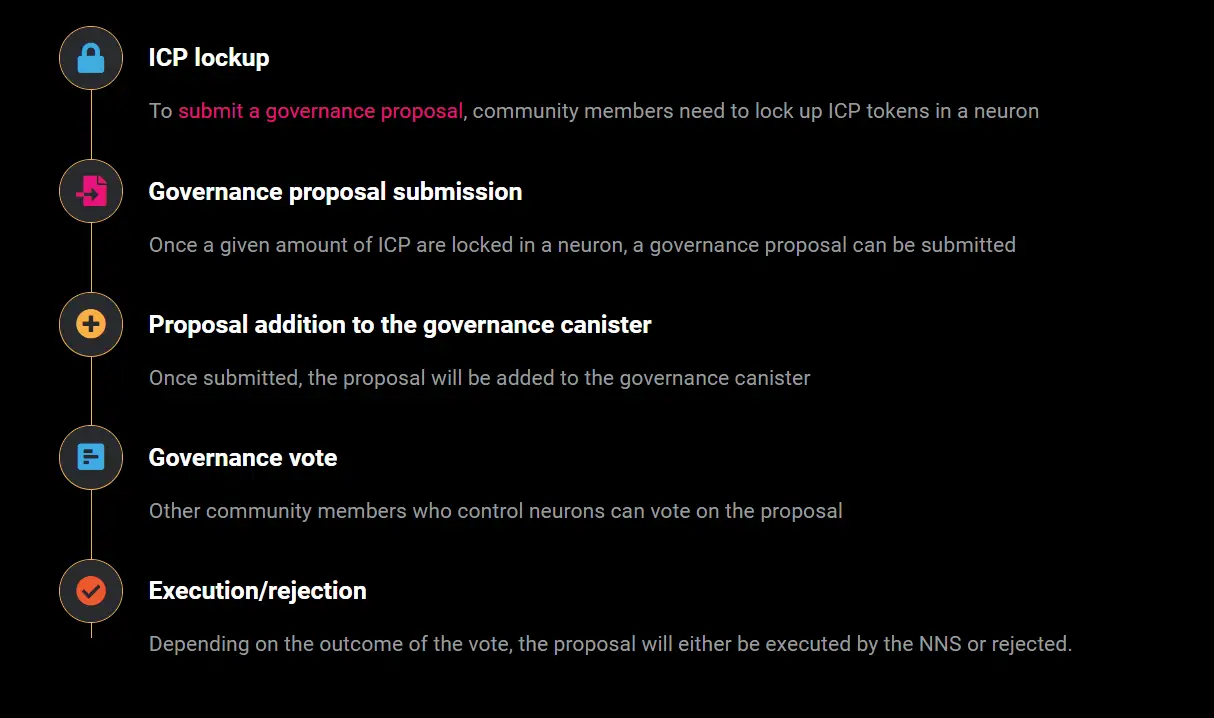The Network Nervous System (NNS) is a core component of the Internet Computer. It governs its blockchain in a decentralized and permissionless manner.
It operates as a decentralized autonomous organization (DAO), enabling anyone to participate by staking ICP tokens in “neurons” and voting on proposals. This ensures that decisions about the network’s upgrades and policies are made collectively by its users.
The Internet Computer, powered by the NNS, runs on a network of independent nodes. These nodes host canisters, which are a new form of smart contracts.
The state of these canisters is replicated across all nodes, ensuring consistency and security across the entire network.
The NNS seamlessly integrates economic management, network structure, and more, all within the blockchain itself.
By participating in the NNS, you can directly influence the direction of the Internet Computer. Stake your ICP tokens, vote on proposals, and be part of a groundbreaking governance model.
This model not only decentralizes decision-making but also continuously evolves based on the collective input of its community. For more details, you can explore the Network Nervous System and learn about its functions.
Fundamentals of the Network Nervous System

The Network Nervous System (NNS) is a crucial part of the Internet Computer blockchain, controlling its governance and updates. It utilizes a decentralized approach involving various components and roles to ensure the network’s integrity and performance.
Core concepts and components
The NNS is a decentralized autonomous organization (DAO) that manages the Internet Computer.
Key components include neurons, ICP tokens, and nodes.
Neurons are created by staking ICP tokens. These neurons can participate in governance by voting on proposals, which helps in making decisions.
The more ICP you stake, the higher your neuron’s voting power.
Nodes are independent machines that run the blockchain, forming subnets to manage different parts of the network. Subnets enhance scalability by distributing workloads.
Canisters are new forms of smart contracts hosted on the Internet Computer. The state of all canisters is replicated across all nodes, ensuring consistency.
Roles and responsibilities
The NNS involves several roles:
1) ICP token holders: Stake ICP tokens to create neurons and participate in voting. Their voting helps in network upgrades and decision-making processes.
2) Voters: Use neurons to vote on proposals. Voting power depends on the amount of staked ICP, and rewards are given based on participation and correctness of the vote.
3) Governance system: An open system where anyone can submit a proposal. The community votes to accept or reject these proposals, ensuring a democratic process.
4) Nodes and subnets: Operate the blockchain, with nodes collaborating within subnets to maintain efficiency and security.
Mechanics of voting and proposals
The Network Nervous System (NNS) plays a crucial role in governing the Internet Computer by allowing token holders to vote on proposals. Below are the mechanisms of how proposals are submitted, how voting works, and the decision-making process in governance.

Proposal submission and types
Anyone can submit proposals to the NNS. You need ICP utility tokens to create and submit proposals.
These proposals can cover a variety of topics such as network upgrades, economic changes, and new node onboarding.
Types of proposals:
- Network upgrades: Proposed changes to the network’s code.
- Economic proposals: Adjustments to the economic parameters or reward schemes.
- Governance changes: Modifications to the governance structure.
Each proposal type has its own set of guidelines and requirements. Once submitted, these proposals are put on a timeline for a community-wide vote.
Voting process and rewards
Voting on proposals is open to all token holders. The process is both straightforward and incentivized.
You need to stake ICP tokens in neurons to vote. Neurons represent locked tokens that generate voting power and rewards.
Voting methods:
- Absolute majority: If more than half the total voting power votes ‘yes’ or ‘no’ before the deadline, the proposal is accepted or rejected instantly.
- Simple majority: If no absolute majority is reached, the proposal results are decided based on the majority of cast votes by the end of the voting period.
Rewards are earned by active participation. Neurons voting on proposals earn voting rewards, which are minted daily and distributed based on activity.
Governance and decision-making
Governance of the NNS is decentralized. Proposals impact everything from network upgrades to governance policies.
The voting power of each neuron determines its influence on decisions.
Governance structure:
- Neurons: Staked ICP tokens locked over a period, which can vary depending on the level of influence desired.
- Proposals: Topics brought forth by the community or foundation, such as technical upgrades or policy changes.
- Decision execution: Approved proposals are implemented automatically, ensuring timely and effective changes.
Internet Computer’s ecosystem structure
The Internet Computer’s ecosystem is a complex structure made up of subnet blockchains, smart contracts called canisters, and a unique economic system. Together, these elements create a decentralized and scalable blockchain platform.
Subnet blockchains and node machines
The Internet Computer Blockchain is made up of various subnet blockchains. Each subnet is a smaller blockchain that helps the entire network scale. These subnets are hosted on node machines.
Node machines, run by independent node operators, are essential. They maintain the network’s health and operation.
Nodes validate transactions, produce new blocks, and store data. The more nodes, the more secure and robust the network.
Smart contracts and canister lifecycle
Smart contracts on the Internet Computer are different from traditional blockchain contracts. They are called canisters.
These canisters can store data and execute code.
Canisters are created by developers to run decentralized applications.
They use cycles, a kind of computational resource. When cycles run out, the canister stops working until more cycles are added.
Canisters can interact with each other and with users. This allows for complex applications that can scale easily.
Importantly, the state of canisters is replicated across all nodes within a subnet, ensuring data integrity and availability.
Technical aspects and development
Understanding the technical aspects of the Network Nervous System (NNS) involves exploring the development environments used by developers and the underlying security protocols that ensure the system’s integrity. These components are critical to the efficient operation and governance of the Internet Computer.
Languages and development environment
The development environment for the NNS is built to support a variety of technologies.
Developers commonly use Rust, Motoko, and C++ to write smart contracts called canisters. Canisters are essential for running applications on the Internet Computer.
- Rust: Known for safety and performance, Rust is widely used for its robust tooling and efficient execution.
- Motoko: Specially designed by DFINITY for the Internet Computer, Motoko simplifies canister development with built-in support for the Internet Computer’s features.
- C++: Offers a balance between control and efficiency, suitable for complex systems.
For front-end interfaces, developers often rely on web technologies such as JavaScript and React. These tools enable seamless interaction between users and the decentralized applications (dApps) running on the Internet Computer.
Chain key cryptography and security
Chain Key Cryptography is central to the security of the Network Nervous System.
This advanced cryptographic protocol enables the Internet Computer to securely manage a massive amount of data across distributed nodes.
- Security: The system ensures that data and transactions are secure without needing traditional consensus mechanisms.
- Efficiency: Chain Key Cryptography allows the Internet Computer Protocol to handle computations reliably and quickly across a global network of nodes.
- Integration: Seamless integration with canisters ensures that smart contracts maintain their integrity and security throughout their lifecycle.
Participation and ecosystem growth
Participation and ecosystem growth within the Network Nervous System (NNS) depend on a robust framework of incentives for stakeholders and a welcoming environment for new community members and developers. These elements together fuel the expansion and evolution of the Internet Computer.
Staking and incentives
Staking ICP tokens is a key part of your participation in the NNS. By staking, you secure the network and earn voting rewards.
When you stake ICP tokens, they are locked in neurons. You can use these neurons to vote on proposals affecting the network.
Voting rewards are an incentive for participating in network governance. The more you participate, the greater your rewards, encouraging active involvement.
These rewards come in the form of newly minted ICP tokens, adding to your stake.
Using Internet Computer wallets enhances your staking strategy’s performance and reliability. These wallets help you manage your staked tokens and monitor voting opportunities.
They also ensure that as an ICP token holder, you stay engaged and motivated by the rewards system.
Community and developer onboarding
Community involvement is crucial for the growth of the NNS. You can participate by proposing changes, voting, or contributing to discussions.
Active engagement helps maintain a democratic and decentralized structure.
For developers, onboarding is made easier using Internet Identity. This system provides a secure and user-friendly way to interact with the network. It encourages you to build dapps and contribute to the ecosystem.
Access to development resources and support is important. The NNS provides ample documentation, tutorials, and a collaborative environment.
Here, you can develop, test, and deploy dapps efficiently. This smooth transition helps you become an integral part of the ecosystem and contribute to its growth.
